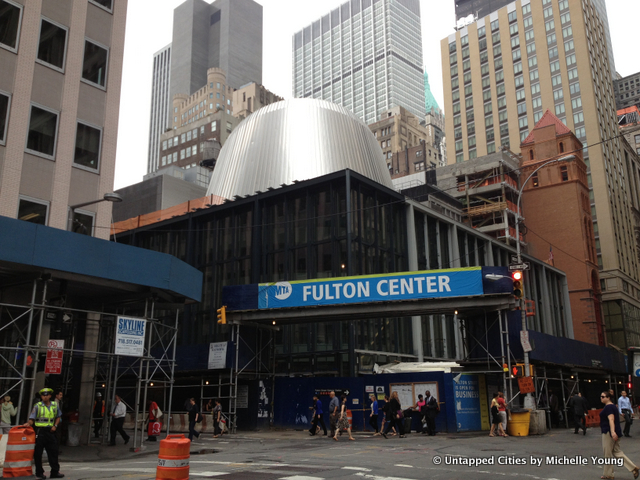 The oculus rises at Fulton Center
The oculus rises at Fulton Center
Lower Manhattan holds centuries of history in its shoreline and beneath its streets. With the sandy beaches of the former New Amsterdam gradually expanding by landfill over the last three centuries, a diverse historical trail has been left in its wake. This is very much the case around the World Trade Center’s site.
Earlier we looked at how the shoreline around the World Trade Center has changed dramatically over time. With The Port Authority digging ever deeper at the site, two sizable artifacts came to light in 2010, reaffirming the area’s rich history.
The first is the Hudson River Bulkhead. Throughout the 19th century, New York was growing as the financial and commercial centre of the United States. Trade was increasing but ships found it difficult to navigate the western shoreline because of varying depths of water in the harbor. In 1870, the first chief engineer of the city’s Department of Docks, Civil War commander, General George B. McClellan, proposed creating a bulkhead to regularize the shoreline. This would allow larger ships to dock at the edge of the island for the first time, as opposed to at the piers and wharves hundreds of feet away from the shore. The Bulkhead effectively opened up Manhattan’s edges to the world of seagoing commerce. Over the next six decades, engineers built the Hudson River Bulkhead, which came to extend over three miles from the Battery to West 59th Street.
Archaeologist, Zachary Davis of The Louis Berger Group, a consulting firm working with The Port Authority, dates the part of the Bulkhead near the World Trade Center to sometime between 1893 and 1896. In 2007, a 40-foot section of the Bulkhead was uncovered during early stages of construction of the East-West connector, the underground passageway linking the Fulton Street subways and the World Financial Center. It could be seen by the public from the World Financial Center’s Winter Garden Atrium.
Today this bulkhead is no longer operational, largely cut off from by the river by massive excavations and landfill projects undertaken during the World Trade Center’s construction during the late 1960s. Still, the Bulkhead had its uses even in the late 20th century. It was covered over by a platform during construction of the World Financial Center in the 1980s, forming part of the structure that captured storm-water runoff and then funneled it out into the Hudson.
As construction of the passageway continued over the summer of 2010, it was necessary to begin removing the Bulkhead. A clear path was needed to run between the World Trade Center and Battery Park City for the East-West Connector. Raymond E. Sandiford, chief geotechnical engineer at Port Authority, is enthusiastic about the passageway project, although his real admiration is in the 19th century construction of the Bulkhead. He explained that a preliminary excavation showed how timber structures from the early 19th century might have been used to act as a bulkhead before this one was built. The hope is that as work continues on the site, more of this historic waterfront will be uncovered and such questions will be answered.
Meanwhile, as Port Authority crews were digging at the site of the South Bathtub between Liberty and Cedar/Albany Streets in 2010, they uncovered parts of an 18th-century ship. The discovery was made about 30 feet down. Experts believe that the vessel was discarded in its location, near the intersection of Washington and Cedar Street, as part of the landfill that helped form Washington Street. The ship is thought to have been constructed in the 1770s near Philadelphia and is recorded to have been a 55-feet long flat-bottomed structure.
Warren Reiss, maritime historian and archaeologist at the University of Maine, said that even after extensive research, there are several things baffling archaeologists. Dubbed the S.S. World Trade Center, Reiss said that there is even uncertainty as to how many masts the ship had. The few clues that we do know about the ship and its purpose have been found in the small objects littered through its remains. Archaeologists have found a small cannon ball and a tiny button belonging to a British infantry unit stationed in New York during the Revolution. It is very likely that the ship was involved in trade.
Along with the Bulkhead, the ship unearths details about life centuries ago as well as the changing geography of Manhattan. The so-called S.S. World Trade Centre has been removed from the site and is now being preserved and studied in the conservation lab at Texas A&M University.
An entire plethora of items are constantly being unearthed in Lower Manhattan. Only earlier this month, an excavation at South Street Seaport revealed more than a hundred liquor bottles, dating back to the 18th century. They were found 7 feet underground in a 15-foot section at the corner of Fulton and Water Street. With the upcoming demolition of the Art Deco building at 68-74 Trinity Place, who knows what else will be uncovered near the World Trade Center.
If you’re interested in the maritime history of the city, check out our article on six famous shipwrecks in New York or look into our two-part piece on the nautical architecture around New York: New York City’s Nautical Architecture: Part I, New York City’s Nautical Architecture: Part II.





